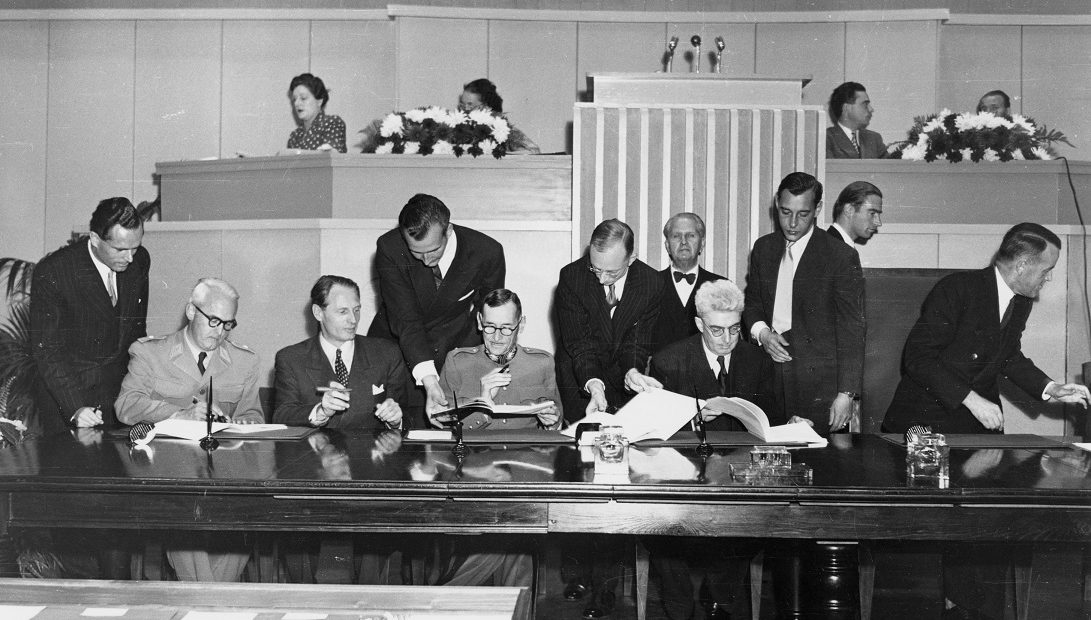With armed conflicts persisting in various parts of the globe and at risk of breaking out in others, it is crucial to take a step back.
In this post, Boyd van Dijk, a McKenzie Fellow at the University of Melbourne, revisits the making of the Geneva Conventions and demonstrates why this history still matters today.
When we think of the making of the Geneva Conventions, many of us conjure images of a stately diplomatic conference with larger-than-life characters racking their brains on how to restrain the conduct of warfare. We also remember the terrible losses of the Second World War – the death camps, mass executions, and millions of civilians killed, epitomized by the Holocaust. And we see the Conventions as a direct response to this enormous wartime suffering.
Yet when the Swiss government invited the world to Geneva in 1949, the gathering was not just one of learning lessons from the war’s past, or filling gaps in the existing Conventions, but also one of preparing for new wars – an experience sounding all too familiar in today’s geopolitical climate.
Our world is very different from the one that shaped the Conventions’ making in 1949. However, against the backdrop of increasing fears of war in Ukraine and over the island of Taiwan and concerns about the future of humanitarian law, it is crucial to return to history. This is not just because the dilemmas that legal experts faced in the 1940s are remarkably similar to the ones of today, but also because history can help us see what is at stake now, and how we might (not) respond to these challenges.
Air bombing
In my newly published book, Preparing for War, I show how the ICRC laid the foundations for the Conventions in the 1940s, as fears of war between the West and Russia were heightening and violence was breaking out across East Asia and in Ukraine. The ICRC put forth many of the most important proposals promoting civilian protection and regulating civil wars.
While officially neutral, the ICRC inevitably had its own political agenda. As the book shows in detail, the organization’s cohort of legal experts faced politically existential dilemmas and rejected utopian plans for humane war. ‘For [this] work to be successful’, said the leading ICRC drafter Jean Pictet, ‘the secret [was] to keep it realistic [ . . . ] nothing is more dangerous than unbridled humanitarianism’.
In the years before 1949, Pictet gathered a select team of legal experts in order to prepare the ICRC’s drafts for the future Conventions. This group discussed a range of issues regarding the regulation of warfare: from outlawing sexual violence, protecting hospitals against air bombing to empowering outside inspections of detainees. What is often forgotten, however, is that questions like these often sparked fierce disagreements within the ICRC about the role of law in so-called ‘humanized war’, and what position it could take as an officially neutral organization from a geopolitically marginal country such as Switzerland.
Like his generational counterpart René-Jean Wilhelm, Pictet believed it was crucial, for example, to develop new rules against indiscriminate bombing. He feared that the decision taken by the Nuremberg Trials to stay silent on the war’s terror bombings would send the wrong signal to the world. The ICRC had to respond differently, he felt. Otherwise, the reborn idea of civilian protection would be at risk of a stillbirth.
More senior ICRC colleagues such as the former president Max Huber, however, feared that such a move – positioning the politically sensitive question of regulating air bombing at the centre of their drafting agenda – would immediately trigger fierce Anglo-American resistance. He was not entirely wrong, since both liberal powers had opposed proposals like these in the past, and would continue to do so in the years after.
In response to enormous Anglo-American pressure, senior ICRC legal experts pushed for the issue to be isolated from Pictet’s drafting agenda. The ICRC in the end endorsed this advice, delaying Pictet’s co-supported initiative to regulate air bombing more strictly to the period after 1949, with vital consequences for civilians today. The Swiss government’s assurance to the Anglo-American powers not to raise legal issues they considered of a so-called ‘political nature’ in order to prevent their walk out from the diplomatic conference came at a serious cost.
Realist humanitarians and idealist States
What this example shows is not just the role of the Anglo-American powers in opposing stricter regulations of destructive weaponry, or how the interests of the Swiss government and the ICRC have always been interconnected. Rather, it calls into question those accounts that portray the ICRC as exclusively ‘idealist’, rather than ‘realist’, as States are often portrayed. In my book, I show why this binary contrast often conceals more than it reveals: there are plenty of cases in which so-called realist States pushed for progressive ideas, whereas the ICRC felt at times forced to prioritize its own institutional interests. This question was crucial, since the ICRC was fiercely criticized after the Second World War for its lack of support for several victim groups of the conflict – especially Jewish civilians and Soviet prisoners of war.
The ICRC’s proposals for civilian protection are another case in point. Pictet closely followed the pioneering work of the UN Human Rights Commission, which was led by Eleanor Roosevelt. Among other things, he read the commission’s reports and observed some of its gatherings in Geneva. Pictet also published his own brochure on human rights in war: a remarkable but often-forgotten document of humanitarian law history.
This document clearly revealed the impact of human rights thinking on Pictet’s legal reasoning while designing the Civilian Convention’s draft: the latter featured references to intangible rights for detainees, banned the use of collective penalties, and guaranteed the principle of humane treatment ‘in all circumstances’.
But Pictet could not ignore the world around him. For example, his team discussed various plans to categorize the States’ own nationals who suffered under persecution under this Convention. Some feared that such a proposal would run the risk of triggering renewed opposition from the Great Powers.
Others believed that the treaty should cover political prisoners, especially those who lacked access to full-blown rights under domestic laws. This clearly referred to the destructive fate of German Jews who had lost their civil rights as a result of the 1935 Nuremberg Laws. In the end, the ICRC decided not to cover these persons under the Convention: in a public speech, Huber argued that the ICRC believed that it would only act successfully when reciprocity was granted, which was not the case with so-called ‘nationals of persecuting States’.
In other words, it is impossible to capture the Civilian Convention’s past exclusively on the basis of a formative experience such as the Holocaust. This explanation fails to clarify why some proposals were codified, whereas others (such as the protection of political prisoners) were deliberately scrapped, and why the experience of genocide did not automatically lead to greater protection for its victims, as is often assumed.
One might wonder how history might have unfolded if Pictet’s argument to restrict air bombing, or attempts to ensure racial minorities of protection under the Conventions, had carried the day. If the hands of resistant State powers had been forced, advocacy groups today might have been in a more powerful position while facing their successors. But it also underscores another crucial point: actors can make a difference. Agency matters.
Drawing the wrong historical lessons
Two other historical insights stand out. First, it is true that those wanting to replicate Geneva’s success today – by reclaiming civilian protection and limiting State sovereignty in exchange for greater humanitarian protection – are facing difficult odds. But one should not make the mistake of drawing the wrong historical lessons from the past: Great Power tensions and fears of war are not a priori reasons for making the greater humanization of warfare impossible.
To the contrary, preparations for war played a crucial part in the explanation for why Geneva succeeded in many of its aims. But the task of today’s advocates of humanitarian law is to decide which of Geneva’s two faces – its claim of protecting victims of war vs. its assurance of preserving State power – will stand out as new wars are being contemplated.
Second, it is important to realize that drafters like Pictet had to grapple with events and other contingencies that they could not control even as a group. They were products of their time, affected by emotions and ideas about new weaponry, fears of war, and the erosion of international norms, as we are witnessing in our era. But how they reacted to these challenges matters enormously: their actions made a difference. Now it is our turn.
See also
- Hugo Slim, A new Solferino moment for humanitarians, February 10, 2022
- Jean-Marie Henckaerts, Two truths and a lie: seventy years of the Geneva Conventions, November 14, 2019
- Daniel Palmieri, Sexual violence in armed conflict: the historical limits of humanitarian action and the ICRC in the 20th Century, December 2, 2021






Very important & valuable “food for thoughts”: “Those who cannot remember the past are condemned to repeat it” Santayana
And again the speaker speaks so well & with a pleasant voice (only that Max Huber was from Zürich and therefore should be pronounced in Schwytzerdütsch https://de.wikipedia.org/wiki/Max_Huber_(Diplomat) although for a long time he was President of our ICRC working in Geneva and abroad)
Félicitations & congartulations!
Dear Jürg,
Thanks very much for taking the time to read our post and to share this valuable feedback. I was indeed wondering if I had correctly pronounced Max Huber’s name! Schwytzerdütsch is still on my list of languages to learn 😉
Many thanks and kind regards,
Lizzie